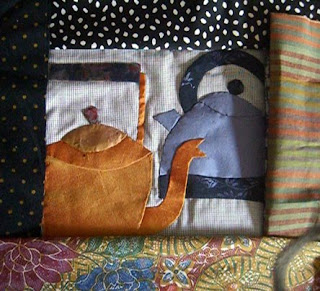 The fabric on the bottom was once a tablecloth that was once used on the boat, where the copper kettle lives. (And before that it was intended as a sarong.)
The fabric on the bottom was once a tablecloth that was once used on the boat, where the copper kettle lives. (And before that it was intended as a sarong.)The borders are now securely attached, and today while stewarding at the London Quilters exhibition (which you can see, quilt by quilt, here) I started quilting them.
This piece is evolving step by step; I woke up one morning with the idea, and got on with it, and am enjoying seeing it develop.
Some people advocate doing all the planning before starting any of the hands-on stuff. In her article in the Summer 2008 issue of the SAQA Journal, Brett Barker advocates doing multiple sketches: "If you can manage to do three or four sketches, you will find that your idea will refine itself without any conscious thought at all." When her "creative" brain has come up with a final sketch, her "thinking" brain can make fabric choices: "Doing preliminary work through sketches allows me the freedom to create without stress - the hard part is done. I can now sit back, relax, and watch my idea realize itself in thread and fabric."
Sounds like a good way of working - or is it a counsel of perfection? Elsewhere I've heard people express horror that some people don't draw anything out before starting a quilt, don't use sketchbooks, don't spend "enough" time planning. Is that always so bad? Is it a Golden Rule to spend 50% of your time doing the planning? Consider the oriental method of working: visualise the result and then do the work; if the outcome seems good, put it away for a few months, then reconsider. Yet another approach is to "act like an artist": do something, and respond to the outcome.
Which of these is (or are) the most appropriate for something as labour-intensive, and as drawn out, timewise, as a quilt?
There are probably as many ways of doing the creative work for a quilt as there are artists making quilts. But let's hope there aren't "design police" ready to lay down the law on this - there are already too many "quilt police" busy inspecting the finished items.
4 comments:
great choices for your border - brings out the copper color. I'd be so bored if I planned out the entire quilt before I made it. Im definitely a play, adjust, sit, play quilter. hear, hear, we definitely don't need any design police. could do without the quilt police too.
What a hoot, Margaret! Design Police - would we have to give them access to our workrooms so they could check out how we had worked, which sounds a bit like City and Guilds, or do you think they will be able to divine our working methods from looking at the final work? Would we be allowed to call ourselves textile artists, quilt artists etc if we don't do as they say? While I'm sure some artists are only responding to the question "how do YOU work?", the earnest pretentiousness of those who advocate THEIR way as the ONLY way make me laugh.
In my opinion there's no right way - only what works for you. Certainly if you're struggling then finding out how others tackle problems is useful but copying other peoples work methods precisely is not that much different from plagiarism.
The process of decision making is the fun part for me - if I designed it all beforehand there would be no point in doing it.
I have very rough sketches and sources of inspiration, dive straight into sample pieces to see what works , what doesn't (they become my journal quilts!) then scale up.
Probably comes from being a scientist - my 'sketchbook' is really like my lab book -recording the hypothesis, methods, results and discussion.
Design Police!! I've been struggling with exactly this issue for what feels like years! For me, when I keep a sketchbook, all the useful stuff goes into that, and I don't get any oomph to take anything further.
I have used thumbnail sketches, about an inch on a side, that are just scribbles, to help me get the balance of elements in a larger piece, but anything bigger just seems to bleed off creative urgency in a direction that isn't fabric/fiber.
Post a Comment